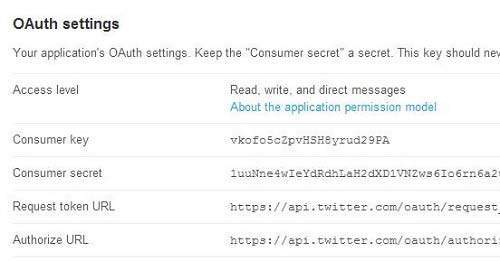Android twitter integration sample code
To keep things clean, create a package com. I have created the enum class SocialNetwork in the same class; you could create a separate file for that if you wish.
- best iphone battery pack 2020.
- free apps for nokia 5230 symbian?
- VIDEO DEMO.
- Authenticate Using Twitter on Android.
The enum class is only for identifying which social network account the user is currently logged in with. This code takes the passed-in UserModel and sends it to the ShareActivity. After completing that, go back to MainActivity. In the onSuccess inside of facebookSetup , write:. The user should only be sent to the Share screen when the user has a valid AccessToken , and this can happen only in the onSuccess block of code. This piece of code is getting the passed in UserModel from the Intent method and passing the data to a new method setData.
Create an App on Twitter
The setData method simply sets up the data in the UI, and includes conditionals that take slightly different actions depending on whether the logged in network is Facebook or Twitter. Now, run your app then tap on Continue with Facebook. Additionally, in your AndroiManifest. Now, open the ShareActivity class and write the method for posting status to Facebook:. This code will present an alert dialog to allow the user to enter a link to share, and then show the user the Facebook share dialog.
Learn2Crack
Your options are links, photos, videos, and other multimedia. Next, in the postButtonAction method, inside the setOnClickListener , add a call to the new function:. Build and run the app again. Logging out is simply a one-line code, but, for logging out, you need to perform two additional tasks. Going over the above: the first line of code allows a user to log out of Facebook. The rest of the lines finish the current activity and take a user to MainActivity. Finally, call this method inside the onOptionsItemSelected like this:.

Like Facebook, you need a working Twitter account in order to integrate Twitter into your app, Twitter provides a Consumer Key and Consumer Secret for communication. Create a CustomApplication class extending from Application under a new package root. Override the onCreate of the Application class as follows:. Then open AndroidManifest.
Subscribe to RSS
Open MainActivity and inside the twitterSetup method, add the following:. Next, open MainActivity and in the success part of the twitterLoginButton callback, add:.
Now, build and run your project and tap on Log in with Twitter. Here, a character limit is applied on the TextView to stop a user from writing more than characters. You can finally see your tweet. Like Facebook, logging out is pretty simple. The Final Project for this tutorial can be found in the Download Materials link at the top or bottom of this tutorial. The TwDialog is a android. Dialog object that will display over the activity. To get a more in depth look at how OAuth works see here. This URL will prompt the user to enter their credentials or cancel.
It then passes those keys to the Twitter. DialogListener that we declared. End Behind the Scenes. The Twitter.
Intent share
DialogListener class is simple and in this example I have only really implemented the onComplete method. The onComplete method will be called when the app has been authorized by the user and will return us the secret token and the access token that we will use to make OAuth calls.
This sample shows how to implement an audio media app that works across multiple form factors and provide a consistent user experience on Android phones, tablets, Auto, Wear and Cast devices. Samples for Android Architecture Components. A collection of samples demonstrating different frameworks and techniques for automated testing.
A fun to play quiz that showcases material design on Android. This library provides APIs for essential app architecture tasks like lifecycle management and data persistence, so you can write modular apps with less boilerplate code. Learn more.
Easily add sign-in to your Android app with FirebaseUI | Firebase
The Data Binding Library enables you to write declarative layouts. Android Test helps you build and run test code for your app. Google Play Billing provides a simple interface for sending billing requests and managing billing transactions with Google Play. Developer Tools. You can install and run your app on the Android Emulator faster than with a physical device. It simulates various device configurations and hardware sensors, and it uses a snapshot to quickly resume exactly where you left off. Run your app. Android Studio uses Gradle, an advanced build toolkit, to automate the build process, while allowing you to define flexible, custom build configurations.
Configure your build. Android Studio includes a layout editor that allows you to build and preview your app UI by dragging elements into a visual design editor instead of writing layout XML by hand. Learn about the layout editor.